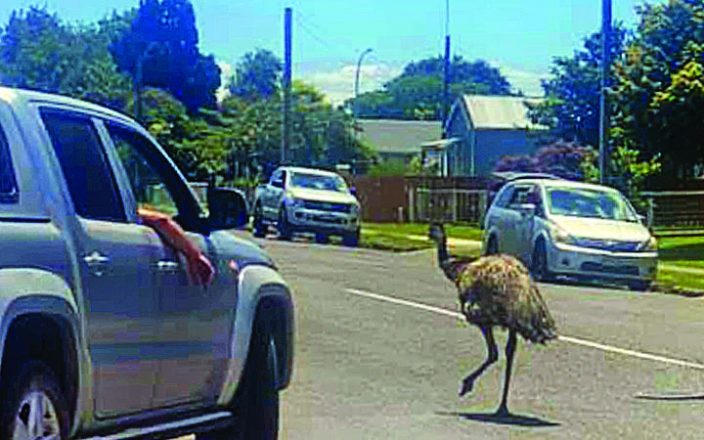First it was roaming horses. Now Ōpōtiki has its own wandering emu, who on Sunday could be seen dodging cars, kids on bikes and local law enforcement.
The unusual escapade did not last long as police swooped to the rescue, escorting the bird back to its Union St paddock in the small Eastern Bay of Plenty town.
The drama unfolded when the emu, a loved pet, was chased from his sanctuary by roaming dogs and was found on the road in a distressed state.
Witnesses told Local Democracy Reporting the emu got into a flap, running up and down Nelson, Wellington and Union streets.
Police were called and the bird was returned to safety on foot.
The scene played out in a video posted to Facebook, where a police officer can be seen walking beside the emu, followed by a police vehicle, which in turn is followed by children on bicycles who are filming the wacky encounter.
Ōpōtiki District Council planning and regulatory group manager Gerard McCormack said the emu was a well-known feature of the town, having lived there for the past 15 years.
McCormack said the emu used to be part of a “lovely” pair, but its partner was sadly killed by dogs some years ago. Emus mate for life.
“The animal control team keep an eye on the emu as part of the regular patrols and the owner always takes care to ensure the emu is fenced and secure and we’ve not had any issues,” he said.
“However, in this instance it appears some dogs were let off-lead and fences were cut, which forced the emu out of the paddock, and it found its way to the road where it was clearly distressed.
“Thanks to the officers who helped steer it back to a fenced paddock and safety.”
In the wild, an emu’s life expectancy is believed to be between 10 to 20 years, but they can live up to 35 years in captivity.
Facebook comments about the emu’s hīkoi show it is a firm favourite in the town. Many people said their children enjoyed feeding the emu and expressed concern for its safety.
There were also several angry comments that someone had allowed their dogs to terrorise the pet.
Others found the event bemusing and posted: “Only in Ōpōtiki”.
This is Ōpōtiki’s only emu escapee, but the council is all too familiar with other roaming livestock.
McCormack said in July that since the Covid-19 lockdown, there had been a huge influx of horses into the township, which was not sustainable given the amount of grazing available.
This had led to more call-outs about horses on roads and in other people’s properties, and complaints of neglect with horses tethered without water or enough grass or in flood-prone areas.
The horses were causing myriad issues, including car crashes, and the council was looking at ways to manage horse numbers in town and was considering a permit or licensing arrangement as part of the Reserves Management Plan.
The owner of the emu declined to comment.
Source: RNZ News – www.rnz.co.nz




























































